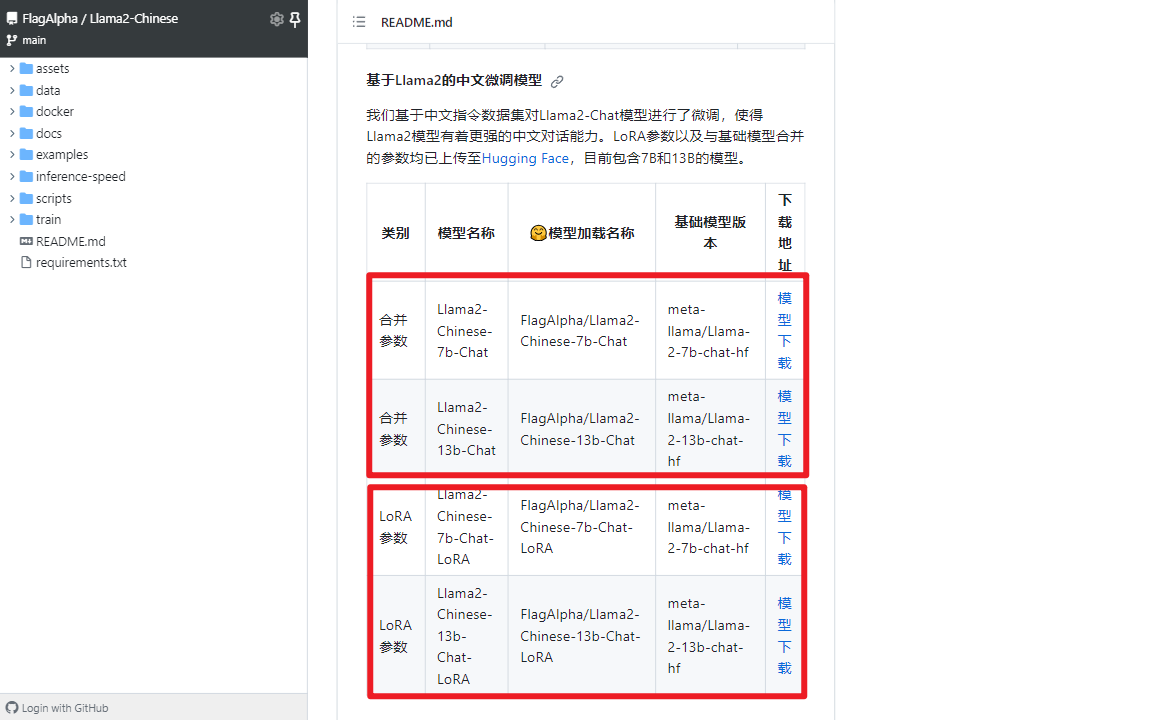一.量化模型调用方式
下面是一个调用FlagAlpha/Llama2-Chinese-13b-Chat[1]的4bit压缩版本FlagAlpha/Llama2-Chinese-13b-Chat-4bit[2]的例子:
fromtransformersimportAutoTokenizer
fromauto_gptqimportAutoGPTQForCausalLM
model=AutoGPTQForCausalLM.from_quantized('FlagAlpha/Llama2-Chinese-13b-Chat-4bit',device="cuda:0")
tokenizer=AutoTokenizer.from_pretrained('FlagAlpha/Llama2-Chinese-13b-Chat-4bit',use_fast=False)
input_ids=tokenizer(['Human:怎么登上火星nAssistant:'],return_tensors="pt",add_special_tokens=False).input_ids.to('cuda')
generate_input={
"input_ids":input_ids,
"max_new_tokens":512,
"do_sample":True,
"top_k":50,
"top_p":0.95,
"temperature":0.3,
"repetition_penalty":1.3,
"eos_token_id":tokenizer.eos_token_id,
"bos_token_id":tokenizer.bos_token_id,
"pad_token_id":tokenizer.pad_token_id
}
generate_ids=model.generate(**generate_input)
text=tokenizer.decode(generate_ids[0])
print(text)
这里面有个问题就是由Llama2-Chinese-13b-Chat如何得到Llama2-Chinese-13b-Chat-4bit?这涉及另外一个AutoGPTQ库(一个基于GPTQ算法,简单易用且拥有用户友好型接口的大语言模型量化工具包)[3]。先梳理下思路,由于meta-llama/Llama-2-13b-chat-hf对中文支持较差,所以采用中文指令集在此基础上进行LoRA微调得到了FlagAlpha/Llama2-Chinese-13b-Chat-LoRA,而FlagAlpha/Llama2-Chinese-13b-Chat=FlagAlpha/Llama2-Chinese-13b-Chat-LoRA+meta-llama/Llama-2-13b-chat-hf,即将两者参数合并后的版本。FlagAlpha/Llama2-Chinese-13b-Chat-4bit就是对FlagAlpha/Llama2-Chinese-13b-Chat进行4bit量化后的版本。总结起来就是如何合并,如何量化这2个问题。官方提供的一些合并参数后的模型[4],如下所示:

二.如何合并LoRA Model和Base Model
网上合并LoRA参数和原始模型的脚本很多,参考文献[6]亲测可用。合并后的模型格式包括pth和huggingface两种。如下所示:
1.LoRA Model文件列表
对于LLama2-7B-hf进行LoRA微调生成文件如下所示:
adapter_config.json
adapter_model.bin
optimizer.pt
README.md
rng_state.pth
scheduler.pt
special_tokens_map.json
tokenizer.json
tokenizer.model
tokenizer_config.json
trainer_state.json
training_args.bin
2.Base Model文件列表
LLama2-7B-hf文件列表,如下所示:
config.json
generation_config.json
gitattributes.txt
LICENSE.txt
model-00001-of-00002.safetensors
model-00002-of-00002.safetensors
model.safetensors.index.json
pytorch_model-00001-of-00002.bin
pytorch_model-00002-of-00002.bin
pytorch_model.bin.index.json
README.md
Responsible-Use-Guide.pdf
special_tokens_map.json
tokenizer.json
tokenizer.model
tokenizer_config.json
USE_POLICY.md
3.合并后huggingface文件列表
合并LoRA Model和Base Model后,生成huggingface格式文件列表,如下所示:
config.json
generation_config.json
pytorch_model-00001-of-00007.bin
pytorch_model-00002-of-00007.bin
pytorch_model-00003-of-00007.bin
pytorch_model-00004-of-00007.bin
pytorch_model-00005-of-00007.bin
pytorch_model-00006-of-00007.bin
pytorch_model-00007-of-00007.bin
pytorch_model.bin.index.json
special_tokens_map.json
tokenizer.model
tokenizer_config.json
4.合并后pth文件列表
合并LoRA Model和Base Model后,生成pth格式文件列表,如下所示:
consolidated.00.pth
params.json
special_tokens_map.json
tokenizer.model
tokenizer_config.json
5.合并脚本[6]思路
以合并后生成huggingface模型格式为例,介绍合并脚本的思路,如下所示:
#步骤1:加载basemodel
base_model=LlamaForCausalLM.from_pretrained(
base_model_path,#基础模型路径
load_in_8bit=False,#加载8位
torch_dtype=torch.float16服务器托管网,#float16
device_map={"":"cpu"},#cpu
)
#步骤2:遍历LoRA模型
forlora_index,lora_model_pathinenumerate(lora_model_paths):
#步骤3:根据basemodel和loramodel来初始化PEFT模型
lora_model=PeftModel.from_pretrained(
base_model,#基础模型
lora_model_path,#LoRA模型路径
device_map={"":"cpu"},#cpu
torch_dtype=torch.float16,#float16
)
#步骤4:将loramodel和basemodel合并为一个独立的model
base_model=lora_model.merge_and_unload()
......
#步骤5:保存tokenizer
tokenizer.save_pretrained(output_dir)
#步骤6:保存合并后的独立model
LlamaForCausalLM.save_pretrained(base_model,output_dir,save_function=torch.save,max_shard_size="2GB")
合并LoRA Model和Base Model过程中输出日志可参考huggingface[7]和pth[8]。
三.如何量化4bit模型
如果得到了一个训练好的模型,比如LLama2-7B,如何得到LLama2-7B-4bit呢?因为模型参数越来越多,多参数模型的量化还是会比少参数模型的非量化效果要好。量化的方案非常的多[9][12],比如AutoGPTQ、GPTQ-for-LLaMa、exllama、llama.cpp等。下面重点介绍下AutoGPTQ的基础实践过程[10],AutoGPTQ进阶教程参考文献[11]。
fromauto_gptqimportAutoGPTQForCausalLM,BaseQuantizeConfig#量化配置
fromtransformersimportAutoTokenizer
#第1部分:量化一个预训练模型
pretrained_model_name=r"L:/20230713_HuggingFaceModel/20230903_Llama2/Llama-2-7b-hf"#预训练模型路径
quantize_config=BaseQuantizeConfig(bits=4,group_size=128)#量化配置,bits表示量化后的位数,group_size表示分组大小
model=AutoGPTQForCausalLM.from_pretrained(pretrained_model_name,quantize_config)#加载预训练模型
tokenizer=AutoTokenizer.from_pretrained(pretrained_model_name)#加载tokenizer
examples=[#量化样本
tokenizer(
"auto-gptqisaneasy-to-usemodelquantizationlibrarywithuser-friendlyapis,basedonGPTQalgorithm."
)
]
#翻译:准备examples(一个只有两个键'input_ids'和'attention_mask'的字典列表)来指导量化。这里只使用一个文本来简化代码,但是应该注意,使用的examples越多,量化后的模型就越好(很可能)。
model.quantize(examples)#执行量化操作,examples提供量化过程所需的示例数据
quantized_model_dir="./llama2_quantize_AutoGPTQ"#保存量化后的模型
model.save_quantized(quantized_model_dir)#保存量化后的模型
#第2部分:加载量化模型和推理
fromtransformersimportTextGenerationPipeline#生成文本
device="cuda:0"
model=AutoGPTQForCausalLM.from_quantized(quantized_model_dir,device=device)#加载量化模型
pipeline=TextGenerationPipeline(model=model,toke服务器托管网nizer=tokenizer,device=device)#得到pipeline管道
print(pipeline("auto-gptqis")[0]["generated_text"])#生成文本
参考文献:
[1]https://huggingface.co/FlagAlpha/Llama2-Chinese-13b-Chat
[2]https://huggingface.co/FlagAlpha/Llama2-Chinese-13b-Chat-4bit
[3]https://github.com/PanQiWei/AutoGPTQ/blob/main/README_zh.md
[4]https://github.com/FlagAlpha/Llama2-Chinese#基于Llama2的中文微调模型
[5]CPU中合并权重(合并思路仅供参考):https://github.com/yangjianxin1/Firefly/blob/master/script/merge_lora.py
[6]https://github.com/ai408/nlp-engineering/blob/main/20230916_Llama2-Chinese/tools/merge_llama_with_lora.py
[7]https://github.com/ai408/nlp-engineering/blob/main/20230916_Llama2-Chinese/tools/merge_llama_with_lora_log/merge_llama_with_lora_hf_log
[8]https://github.com/ai408/nlp-engineering/blob/main/20230916_Llama2-Chinese/tools/merge_llama_with_lora_log/merge_llama_with_lora_pt_log
[9]LLaMa量化部署:https://zhuanlan.zhihu.com/p/641641929
[10]AutoGPTQ基础教程:https://github.com/PanQiWei/AutoGPTQ/blob/main/docs/tutorial/01-Quick-Start.md
[11]AutoGPTQ进阶教程:https://github.com/PanQiWei/AutoGPTQ/blob/main/docs/tutorial/02-Advanced-Model-Loading-and-Best-Practice.md
[12]Inference Experiments with LLaMA v2 7b:https://github.com/djliden/inference-experiments/blob/main/llama2/README.md
[13]llama2_quantize_AutoGPTQ:https://github.com/ai408/nlp-engineering/blob/main/20230916_Llama2-Chinese/tools/llama2_quantize_AutoGPTQ.py
服务器托管,北京服务器托管,服务器租用 http://www.fwqtg.net
机房租用,北京机房租用,IDC机房托管, http://www.fwqtg.net
相关推荐: Code Llama:Llama 2 学会写代码了!
引言 Code Llama 是为代码类任务而生的一组最先进的、开放的 Llama 2 模型,我们很高兴能将其集成入 Hugging Face 生态系统!Code Llama 使用与 Llama 2 相同的社区许可证,且可商用。 今天,我们很高兴能发布 Hugg…

